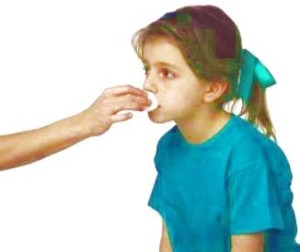The inner lining of the nose has thin, delicate and tiny veins which can be easily injured or damaged. When any of these veins gets ruptured, either due to picking of the nose, getting knocked down, blowing the nose a tad too hard or having inserted an alien object into the nose, it causes nosebleeds in children.
Nosebleeds in children are scary situations for them due the sight and loss of blood. Hence, parents must be extremely careful about how they approach the situation and console the child, when he/she has a nosebleed.

Causes of nosebleeds in children
Some of the causes and risk factors of nosebleeds in children are as follows:
• When the membranes in the nose become dry due to the lack of moisture in the air or due to dry air then they are more vulnerable to infections and bleeding.
• Nose picking, which can be sometimes be a little hard in the case of children can eventually lead to nosebleeds in children
• Existing conditions in children like acute sinusitis, chronic sinusitis, allergies, nasal infections, common cold, nonallergic rhinitis and a deviated septum increase the risk of nosebleeds in children
• The use of blood thinning medications, aspirin or other nonsteroidal anti-inflammatory drug and nasal sprays, presence of ammonia or chemical irritants in the vicinity of children, a foreign object in the nose and nasal trauma or injury may result in nosebleeds in children.
• In rare cases nasal tumors, leukemia, infection of the upper respiratory tract or nasal polyps may cause nosebleeds in children
Treatment and prevention of nosebleeds in children
There are several ways in which parents can assist their children in stopping nosebleeds. A visit to a doctor is essential only in certain cases as mentioned below:
• If the bleeding does not stop for more than 25 to 30 minutes.
• If the nosebleeds are frequent and have a duration of 15 minutes or above on each occasion.
• If there is an alien object in the child’s nose, its best left to a doctor to remove it rather than taking the risk of pushing it further in
• If the child has difficulty in breathing.
• If the nosebleed is the result of a trauma or injury to the head.
Parents can follow the steps given below or teach them to their children in case of nosebleeds:
• Make the child sit down and lean forward a little bit. When a child is in a lying position, the blood pressure in the head increases and causes the blood to rush towards it. This may result in blood flowing to the throat, thereby causing gagging or vomiting.
• Pinch down and hold the lower soft portion of the nose for about ten minutes. This allows for the blood in the nose to clot and thus stop the nosebleed.
• Once the nosebleeds in children have stopped, they should avoid picking their nose or sneezing loudly, rest for some time and stay on a soft diet for at least 24 hours.
• In addition, parents may apply an ice towel to the cheeks and nose.